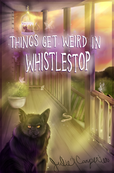Sacred Chickens
Menu
SACRED CHICKENS
 Plants of the Underworld by Jarad Johnson Whenever we think of the Underworld, especially in Greek Mythology, we think of a barren wasteland, devoid of any life. In reality, the Greeks really saw the Underworld, not as hell as the Christian tradition knows, but as a multifaceted world, one where souls travelled when they died. It was much more complex and three dimensional than the hell we know today, as there are actually five regions and five rivers that run through it. But, as a gardener, I of course paid attention to the plants. There are many plants that are associated with that realm, and I thought it might fun to go through some of them. Abandon all hope, ye who enter here. Or abandon your plants. I will gladly take them. Pomegranate- “The Fruit of the Dead.” Often referred to as the symbol of death and fertility, pomegranates feature strongly in the mythology of Ancient Greece, specifically in the story of Persephone. As it goes, Hades kidnapped Persephone and carried her to the underworld. She was going to be rescued, but Hades had tricked her into eating some pomegranate seeds, which according to the laws of the Fates, meant that she had to stay there. However, Zeus intervened, and Persephone was permitted to leave the underworld for part of the year. This was how the Greeks explained the changing of the seasons, meaning that right now Persephone has made her way to Hades. Thus, the pomegranate has great symbolism for the Ancient Greeks. As Persephone is both a goddess of life and death, so the pomegranate came to symbolize both life and death. Some even say it grows in the Underworld! Cypress- “The Mournful Tree.” This story centers on a youth named Cyparassisus was a youth whom Apollo was in love with. Cyparassisus had a stag with whom he was very attached to and was his favorite companion. One day, Cyparassisus accidentally struck the stag and killed it. His grief was so great that he laid beside the creature and transformed into a tree. Cypresses were planted near graves or vestibules to signify hallowed ground and to warn against entering. If one was buried in a coffin made of cypress, it signified everlasting life. This honor was usually reserved for heroes. Bodies of the honored were also placed upon a bed of cypress branches before burial. Mourners would carry cypress branches as a sign of grief and respect. Asphodel- The Fields of Death. Though we may only know the Fields of Asphodel as the place in the Underworld where most souls who were not heroes or villains went in death, there is actually a real species called Asphodelus, identified in the 1700s. Comprising of about 16 different subspecies, the Asphodelus genus is most known for its white variety, Asphodelus Albus. No doubt its white color made strong associations with death over the years and is said to have been planted at tombs. Typically, the Fields of Asphodel were thought to be a peaceful place of rest for the dead, although, as much as I love flowers, after a few centuries, I’d get very bored. Narcissus- The Lure of Vanity There are two myths associated with this plant. The first is the more well known, that of a youth named Narcissus who fell in love with his own reflection in a pool of water and died there. The second involves Persephone, who was lured away from her companion while picking flowers by a patch of Narcissus flowers. There waiting, was Hades, who kidnapped her and took her to the Underworld. I personally just like to pick them in the spring when they flower. Just watch out for Hades! Poppy- The Hypnotic Medicine This particular plant with its lurid history was associated with Morpheus (where the word morphine comes from), the god of sleep, and was also a symbol of death in that culture. Milk of the poppy was a common medicine for pain relief in the ancient world, but sometimes a dose too large had adverse effects. Perhaps the opium dens of the Victorians might tell us why! Red Anemone- The Blood of the Hero This flower is associated with the death of Adonis, who was loved by both Persephone and Aphrodite. One day, Adonis wounded a fierce boar, which stabbed him with his tusks. Where drops of Adonis’s blood fell, red anemones sprang forth. The Hyacinth- The Lover’s Grief. Here again we see the god Apollo falling in love with a young man; this time, his name was Hyacinthus. However, the god the wind, Zephyrus, was jealous of them, and during a discus throwing contest, Zephyr caused the wind to make the disc strike Hyacinthus in the head. While Apollo was grieving the loss of Hyacinthus, a flower sprang up from where his blood had soaked the ground. Apollo named it after his lover and ordered a three-day festival in his honor. Aconite (Wolf’s Bane)- The Weapon of the Witch. Often used by a poison in ancient times, the plant was called akoniton (without soil) because it grows on rocky ground. It got its name in the myth of the twelve labors of Heracles. As part of one of his labors, he was sent to fetch the beast Kerberos from the Underworld. The spittle of Kerberos dripped on the ground and sprang forth the first aconite plant. Medea, the famous witch, tried to poison her husband’s son, Theseus, with the plant. King Aegeas fortunately, recognized a sword he had given Theseus as a mark of his parentage, and knocked the cup out of his hand in time.  Bio: Jarad recently graduated from college at MTSU, loves tea and coffee, and tries to spend every spare second reading. He has been a fervent gardener for 6 years and is fascinated by all related topics and has spent the last several years writing about this passion. He believes that nature is our greatest teacher. He majored in English with a concentration in literature and plans to pursue and master’s degree in Ecocriticism.
0 Comments
Leave a Reply. |

Click Photo above to buy ebook or paperback from Amazon.
Here's the link to Barnes and Noble Or order through your favorite independent bookstore! Categories
All
|
 RSS Feed
RSS Feed